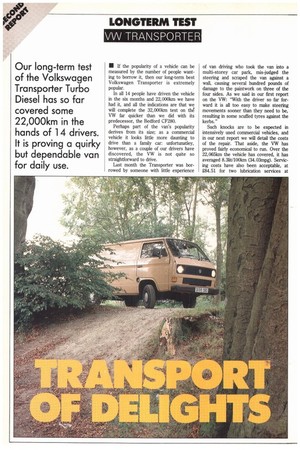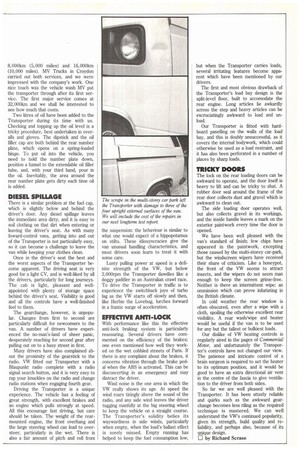Our long-term test of the Volkswagen Transporter Turbo Diesel has
Page 66

Page 67

If you've noticed an error in this article please click here to report it so we can fix it.
so far covered some 22,000km in the hands of 14 drivers. It is proving a quirky but dependable van for daily use.
• If the popularity of a vehicle can be measured by the number of people wantMg to borrow it, then our long-term best Volkswagen Transporter is extremely Popular.
In all 14 people have driven the vehicle in the six months and 22,000Iun we have had it, and all the indications are that we will complete the 32,0004an test on the VW far quicker than we did with its predecessor, the Bedford CF280.
Perhaps part of the van's popularity derives from its size; as a commercial vehicle it looks little more daunting to drive than a family car: unfortunatley, however, as a couple of our drivers have discovered, the VW is not quite so straightforward to drive.
Last month the Transporter was borrowed by someone with little experience of van driving who took the van into a multi-storey car park, misjudged the steering and scraped the van against a wall, causing several hundred pounds of damage to the paintwork on three of the four sides. As we said in our first report on the VW: "With the driver so far forward it is all too easy to make steering movements sooner than they need to be, resulting in some scuffed tyres against the kerbs."
Such knocks are to be expected in intensively used commercial vehicles, and in our next report we will detail the costs of the repair. That aside, the VW has proved fairly economical to run. Over the 22,065km the vehicle has covered, it has averaged 8.31k/100km (34.03mpg). Servicing costs have also been acceptable, at 2.84.51 for two lubrication services at 8,000km (5,000 miles) and 16,000km (10,000 miles). MV Trucks in Croydon carried out both services, and we were impressed with the company's work. One nice touch was the vehicle wash MV put the transporter through after its first service. The first major service comes at 32,000km and we shall be interested to see how much that costs.
Two litres of oil have been added to the Transporter during its time with us. Checking and topping up the oil level is a tricky procedure, best undertaken in overalls and gloves. The dipstick and the oil filler cap are both behind the rear number plate, which opens on a spring-loaded hinge. To put oil into the vehicle, you need to hold the number plate down, position a furmel to the extendable oil filler tube, and, with your third hand, pour in the oil. Inevitably, the area around the rear number plate gets dirty each time oil is added.
DIESEL SPILLAGE
There is a similar problem at the fuel cap, which is slightly below and behind the driver's door. Any diesel spillage leaves the immediate area dirty, and it is easy to soil clothing on that dirt when entering or leaving the driver's seat. As with many foward-control vans, getting into and out of the Transporter is not particularly easy, so it can become a challenge to leave the van while keeping your clothes clean.
Once in the driver's seat the best and the worst aspects of the Transporter become apparent. The driving seat is very good for a light CV, and is well-liked by all the drivers, particularly for long journeys. The cab is light, pleasant and wellappointed with plenty of storage space behind the driver's seat. Visibility is good and all the controls have a well-finished. feel to them.
The gearchange, however, is unpopular. Changes from first to second are particularly difficult for newcomers to the van. A number of drivers have experienced the no-man's-land of sheer panic, desperately reaching for second gear after pulling out on to a busy street in first_ Many drivers have also complained about the proximity of the gearstick to the radio. VW fitted our Transporter with a Blaupunkt radio complete with a radio signal search button, and it is very easy to rap your knuckles on the radio and change radio stations when engaging fourth gear.
Driving the Transporter is a unique experience. The vehicle has a feeling of great strength, with excellent brakes and an engine which pulls strongly at speed. All this encourage fast driving, but care should be taken. The weight of the rearmounted engine, the front overhang and the large steering wheel can lead to oversteer, particularly in the wet. There is also a fair amount of pitch and roll from the suspension: the behaviour is similar to what one would expect of a hippopotamus on stilts. These idiosyncracies give the van unusual handling characteristics, and most drivers soon learn to treat it with some care.
Lusty pulling power at speed is a definite strength of the VW, but below 2,000rpm the Transporter dawdles like a doggy paddler in an Australian crawl race. To drive the Transporter in traffic is to experience the switchback joys of turbo lag as the VW starts off slowly and then, like Herbie the Lovebug, lurches forward in a frantic surge of acceleration.
EFFECTIVE ANTI-LOCK
With performance like this the effective anti-lock braking system is particularly reassuring. Several drivers have commented on the efficiency of the brakes; one even mentioned how well they worked on the wet cobbled streets of Paris. If there is any complaint about the brakes, it concerns vibration through the brake pedal when the ABS is activated. This can be disconcerting in an emergency and may distract the driver.
Wind noise is the one area in which the VW really shows its age. At speed the wind roars tiringly above the sound of the radio, and any side wind leaves the driver tugging manfully at the big steering wheel to keep the vehicle on a straight course. The Transporter's solidity belies its waywardness in side winds, particularly when empty, when the load's ballast effect is sorely missed. Empty running has helped to keep the fuel consumption low, but when the Transporter carries loads, several irritating features become apparent which have been mentioned by our drivers.
The first and most obvious drawback of the Transporter's load bay design is the split-level floor, built to accomodate the rear engine. Long articles lie awkardly across the step and heavy articles can be excruciatingly awkward to load and unload.
Our Transporter is fitted with hardboard panelling on the walls of the load bay, and this is doubly unsuccessful, as it covers the internal bodywork, which could otherwise be used as a load restraint, and it has also been perforated in a number of places by sharp loads.
TRICKY DOORS
The lock on the rear loading doors can be awkward to operate, and the door itself is heavy to lift and can be tricky to shut. A rubber door seal around the frame of the rear door collects dust and gravel which is awkward to clean out.
The side loading door operates well, but also collects gravel in its workings, and the inside handle leaves a mark on the exterior paintwork every time the door is opened.
We have been well pleased with the van's standard of finish; few chips have appeared in the paintwork, excepting those caused by the multi-storey car-park, but the windscreen wipers have received their share of criticism. Like a honeypot, the front of the VW seems to attract insects, and the wipers do not seem man enough to keep the screen grime-free. Neither is there an intermittent wipe: an ommission which can prove infuriating in the British climate.
In cold weather the rear window is often obscured, even after a wipe with a cloth, spoiling the otherwise excellent rear visibility. A rear wash/wipe and heater would be useful if the van is to be used for any but the tallest or bulkiest loads.
Our dislike of VW heating controls is regularly aired in the pages of Commercial Motor, and unfortunately the Transporter's controls have not changed our view. The patience and intricate control of a brain surgeon is required to set the heater to its optimum position, and it would be good to have an extra directional air vent in the centre of the fascia to give ventilation to the driver from both sides.
So far we are well pleased with the Transporter. It has been utterly reliable and quirks such as the awkward gearchange becomes less riling as the required technique is mastered. We can well understand the VW's continued popularity, given its strength, build quality and reliability, and perhaps also, because of its unique design. Li by Richard Scrase
























































































































